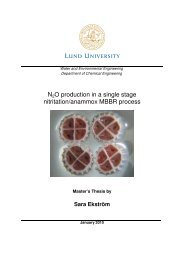Bättre EU-regler för en giftfri miljö - Kemikalieinspektionen
Bättre EU-regler för en giftfri miljö - Kemikalieinspektionen
Bättre EU-regler för en giftfri miljö - Kemikalieinspektionen
Create successful ePaper yourself
Turn your PDF publications into a flip-book with our unique Google optimized e-Paper software.
place in 2018. The improvem<strong>en</strong>ts should be aimed at prioritising substances by<br />
id<strong>en</strong>tifying groups which need to be tested further, not at introducing g<strong>en</strong>eral new<br />
requirem<strong>en</strong>ts for all substances. In the longer term the requirem<strong>en</strong>t of a risk assessm<strong>en</strong>t<br />
(chemical safety report) must also apply to low-volume substances.<br />
• REACH is aimed at individual substances and is not suited to dealing with groups of<br />
substances, such as nanomaterials. We consider that, in time, REACH must be <strong>en</strong>hanced<br />
on this point.<br />
• As a result of REACH an extremely compreh<strong>en</strong>sive database is being built up with<br />
knowledge about chemicals. Much of the information will be public, but there is also a<br />
need for processed, structured and more easily accessible information which users,<br />
consumers and waste managers can access and b<strong>en</strong>efit from.<br />
We also point to the very strong international tr<strong>en</strong>d towards a ”new toxicology”. A basic idea<br />
behind this is to replace testing which involves animals with alternative methods. At least in<br />
the USA, however, the approach is much broader and g<strong>en</strong>erally aims at new and more<br />
effici<strong>en</strong>t methodology to evaluate hazardous properties in chemicals. In the longer term this<br />
tr<strong>en</strong>d can be very significant for REACH, and we consider that the <strong>EU</strong>, and also Swed<strong>en</strong>,<br />
must be involved in this developm<strong>en</strong>t to a greater ext<strong>en</strong>t than at pres<strong>en</strong>t.<br />
Pesticides (Chapter 6.1)<br />
The <strong>EU</strong> rules regarding the approval of pesticides are completely new in the <strong>EU</strong>. The<br />
regulation regarding plant protection products was issued in 2009 and the new regulation<br />
regarding biocidal products is, in principle, ready but has not be<strong>en</strong> published at the time of<br />
writing. The rules come very close to Swedish priorities under the <strong>en</strong>vironm<strong>en</strong>tal objective of<br />
A Non-Toxic Environm<strong>en</strong>t. The great chall<strong>en</strong>ge lies in making the technically complicated<br />
rules work effectively as int<strong>en</strong>ded. We feel that Swed<strong>en</strong> should, in the future, work towards<br />
the rules being simplified wh<strong>en</strong>ever possible. With regard to plant protection products, the<br />
rules should be applied so that physically acting products do not need to be tested and<br />
approved separately.<br />
<strong>EU</strong> rules regarding the use of pesticides exist in respect of plant protection products but not<br />
with regard to biocidal products. We feel that common rules are needed for the use of biocidal<br />
products, e.g. for the reason that the use is closely linked to approval testing. A review of this<br />
issue will take place in 2015 wh<strong>en</strong> the Commission is due to submit a report. We should<br />
support the Commission in its work on the review.<br />
Foods (Chapter 6.2)<br />
The <strong>EU</strong> has a very ext<strong>en</strong>sive body of legislation governing foods and materials in contact<br />
with foods, which is of great importance for the managem<strong>en</strong>t of risks associated with<br />
chemicals. The European Food Safety Authority (EFSA) plays an important role in this area.<br />
We id<strong>en</strong>tify sev<strong>en</strong> issues where there is a need for further measures in the area of foods:<br />
• There is a need to review packaging materials for foods, e.g. paper, among other things<br />
with regard to the pres<strong>en</strong>ce of printing ink compon<strong>en</strong>ts, perfluorinated substances and<br />
mineral oil. The limit value for lead in ceramic glazes needs to be lowered.<br />
• Certain foreign substances in foods are curr<strong>en</strong>tly unregulated and there is a need for<br />
further risk assessm<strong>en</strong>t and possible risk managem<strong>en</strong>t. Examples of these are<br />
perfluorinated substances and brominated flame retardants.<br />
• There is a lack of rules at <strong>EU</strong> level regarding materials in contact with drinking water.<br />
There is also a need to review rules governing metals in drinking water.<br />
22















